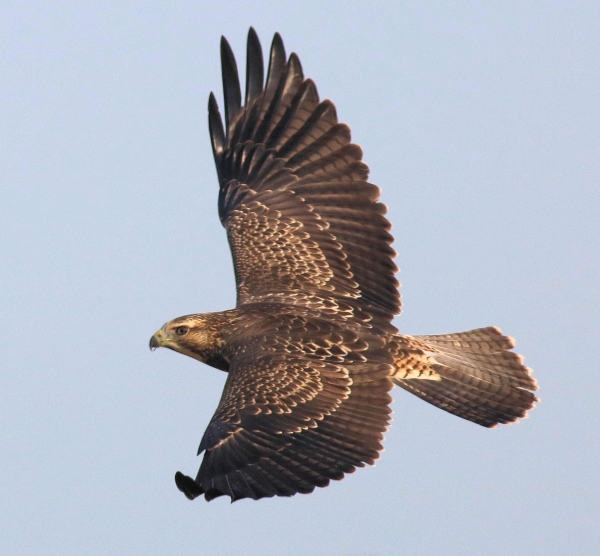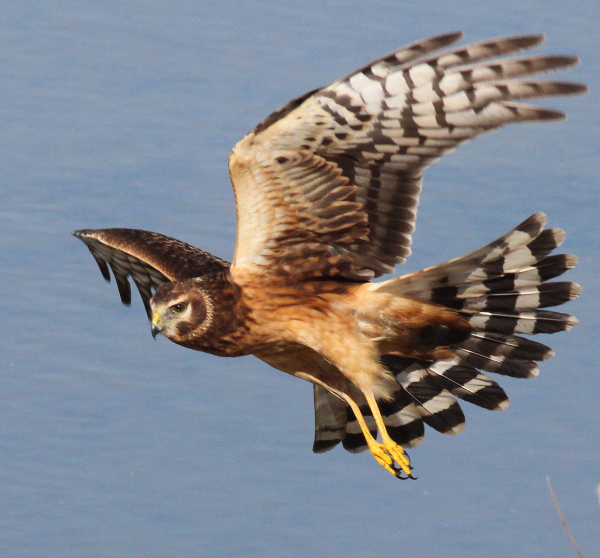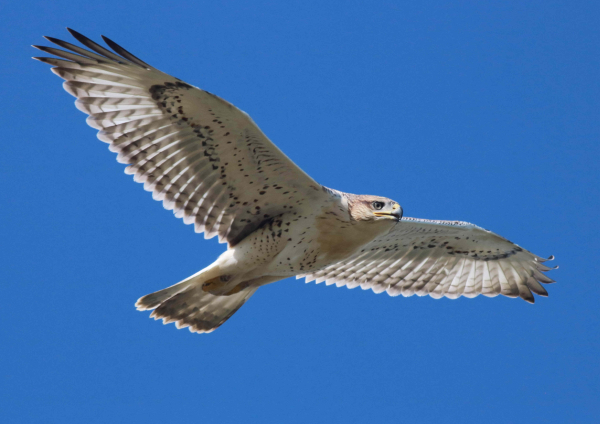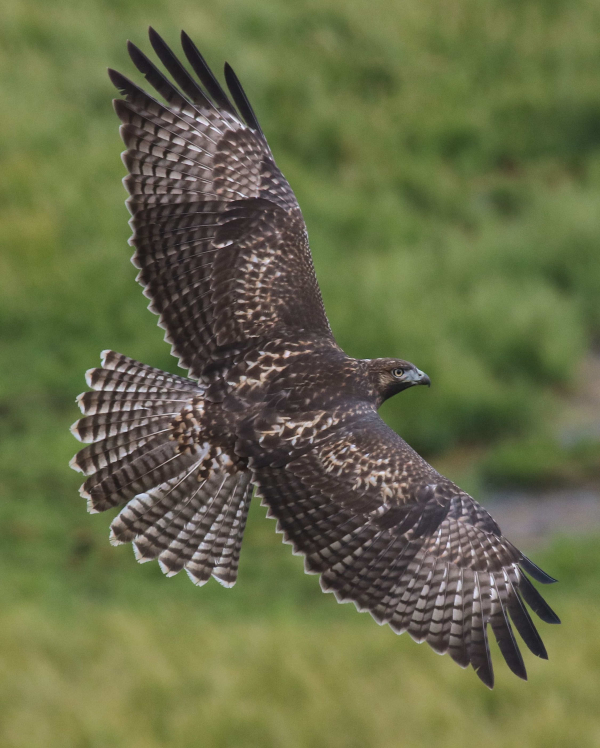Earlier I mentioned that I live in the midst of a renowned duck nesting region, but central North Dakota provides a mosaic of mixed habitats that attracts an abundance of prairie hawks: Swainson’s, Ferruginous, and Red-tailed Hawks – the Buteos – and Northern Harriers, the specialized North American representative of the Harrier genus. I began my career studying hawks and owls in this region (along with waterfowl, and cranes worldwide), so I have considerable experience photographing the raptors of the Great Plains. As a result, I have a multitude of photographs of each of these hawks as nestlings, fledglings, and adults; but, realistically, I’ve taken some of my best photos of fledgling hawks in flight during the past three summers, after returning to this area from southern California.

Part of that photo success comes from covering a lot of ground, almost daily; finding hawk nest sites in the spring, monitoring nesting progress through the summer, and studying young hawks during the post-fledging period after they leave the nest. I learn the habits of the fledglings, where they hang out, what perches they use, where they are hunting. Then, keeping the optimum sunlight periods of early morning and late afternoon in mind, I check back on the birds almost daily to see if I can find them in a position that will give me a photo opportunity. Sometimes that opportunity is dictated by something as simple as which side of the road they are perched at, or if my path crosses theirs as they fly from one location to another, or soar overhead.
My patience has improved considerably during recent years. I’ve learned how fulfilling it is to spend time with a bird, and it can be most rewarding to learn more about the species behavior while waiting to get a classic portrait or a series of different images. If the fledgling hawk is relaxed with your close proximity, and you are relaxed, be thankful for the opportunity but ready for any quick action that may transpire.

Persistence and patience have made a big difference in the quality of the photos I take. Practice and experience have helped to improve my reaction speed and anticipation with my camera in hand. Try to keep these qualities in mind and use them to your advantage in the field too.
The simple photo techniques I use should also be helpful for you: 1) using my vehicle as a mobile blind, 2) turning off the vehicle while photographing, 3) bracing my camera lens against the window frame of the vehicle, 4) holding my breath as I take photos, 5) trying not to over-react to an exciting photo opportunity, 6) trying not to tense-up during a photo op, 7) following the flight of a given hawk through my camera’s viewfinder fluidly with a steady hand, 8) emphasizing a fast shutter speed while using an ample field of focus – usually using a standard f8 aperture to achieve this balance, and 9) never getting out of the vehicle unless necessary.
Hawks are wary birds, so getting out of a vehicle is rarely productive unless the bird flies overhead and your only means of seeing and photographing it is to get your feet on the ground and follow the hawk in flight with your camera. I would emphasize not getting out of your vehicle for any vehicle-based photography that may include birds and mammals – the action of the swinging door, your moving feet and raised camera are usually just too much activity for the animal to react to in any way aside from fleeing. I see it all the time in national parks where people unfamiliar with wildlife try to photograph with their cell phones or tablets or a camera, who scare subjects that they expect to continue their relaxed behavior like animals in a zoo.

When approaching a hawk in a vehicle, I slow down gradually, approach the bird with a bit of apprehension, watching to see how it is reacting to my approach and trying to gauge if the hawk might flush prematurely if I continue to advance – or whether I need to stop, wait, and photograph from a distance, before considering a closer approach if it seems the bird becomes comfortable enough for that option. Or I wait to see if the bird might fly on its own accord, hopefully in my direction for some pleasing photos.
When we photograph, it’s important to keep the birds’ welfare in mind. How will our approach affect the birds? If they are hunting, will they lose a feeding opportunity? If they have caught prey and are feeding, will they abandon the prey if they flush? The welfare of wild birds comes first. At the same time, birds are constantly relocating, taking flight, and adjusting to current conditions; and they sometimes simply circle back to their original perch, or merely fly to the next tree or post or pole to resume their activities. Overall, be aware, and be considerate; and appreciate that the most rewarding part of bird photography can be when you do not affect the activities of your subject, when you can leave the bird just as you found it, with or without photos.
Fledglings offer a little different set of circumstances for photographers, partly because we may not only upset the fledgling, but we may well upset the adults that are protecting the young hawk during the sensitive post-fledging period when fledglings learn to fly and hunt and protect themselves. This period usually lasts for four to six weeks among the Buteo hawks, but it may continue after hawks leave their nesting territory.

With these life history and birding ethics aspects of the post-fledging season in mind, fledgling hawks tend to be a bit more trusting than adults; they tend to limit their movements more than adults, and they are a little slower than adults when they fly, seemingly reading the effect of wind and landscape rather than reacting instinctively in flight as an adult seems to do. This behavioral and physical difference can make photographing fledglings a bit easier, and a bit more productive. Then too, the young hawks can convey a sense of interest and wonder not unlike that sometimes portrayed by a child, leaving me to enjoy photo interactions with them a little more.
When the stars align, when you have a fledgling hawk in flight with just the right light, teetering in the wind, or making a banking turn, keep your wits about you, get the bird in your field of view – in focus – follow it, and take a few photos as it arches and raises a wing into the wind to bank toward you on widespread wings. Then follow the hawk as it glides at an angle to your position and keep documenting its progress with regular finger snaps of your shutter button. Feels good, feels right, feels like you took some memorable images; exhale, and keep an eye on the bird – it may circle back for another photo round.
Of course, all the techniques and suggestions provided here for photographing fledgling hawks can be used for any raptors, and any birds. If you can photograph recently fledged raptors, you shouldn’t have any problem photographing any kind of animal with feathers – or any others.
The fact that fledgling hawks are feathered with their first-year plumages makes them special too. Although fledglings resemble adults in their size and build, there are some obvious plumage clues that indicate they are first year birds, and they keep this plumage for 12 to 15 months. For Red-tailed Hawks, the most obvious difference is the brown tail color rather than orange; for Ferruginous Hawks, it’s the lack of the namesake ferruginous orange coloration on the legs and back. First year Swainson’s Hawks lack of the dark breast “bib” and the white belly of adults; and first year Northern Harriers have a rich rufous coloration that distinguishes them from adult females and males.
Photographing fledgling hawks will help you to identify and distinguish first year birds from adults, and allow you to compare species to species, individual to individual. It will make you a better birder; and a better photographer with the practice and improvements that follow. Even after fledglings are on their own and migrating southbound, these first-year hawks provide exciting and interesting opportunities to photograph these regal birds in flight. Appreciate their appearance on the landscape around you and enjoy photo opportunities they may provide during fall migration too.
Article and photographs by Paul Konrad
Share your bird photographs and birding experiences at editorstbw2@gmail.com